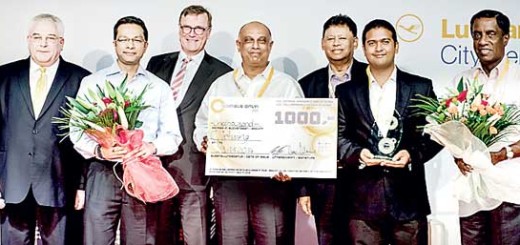UNFOLDING STRENGTH
by Jetwing · Published · Updated
Sri Lanka has welcomed an upsurge in visitors over the past five years. Stefanie Saghbini sets out to discover how stakeholders are achieving this result and how they plan to sustain it
Sri Lanka, a significant albeit small-in-size pearl of touristic wonders, is gradually and confidently paving its own way into the global tourism spotlight as it rapidly gains recognition as a leading long-haul destination of choice for travellers the world over.
Tourism in Sri Lanka has been booming over the past few years, since peace dawned on the country in 2009, as director of sales and marketing, Amaara Sky Hotel, Kandy, Danukh Amerasinghe revealed to TTG.
“Due to the substantial investments towards infrastructure and tourism by both the state and private sector, these numbers can only go up. Sri Lanka is blessed to have the capability to cater to a diverse clientele, whether it is backpackers on a budget or luxury travellers,” she explained. Echoing these views to TTG was CEO, Serene Pavilions, Anura Lokuhetty who also noted the tremendous improvement in the informal tourism sector, particularly over the past three years, which, he explained, comprises guest houses and home stays, to name a few. “This has helped to improve community participation in the tourism industry,” he elaborated.
Further proving the ever-growing popularity of this blossoming gem, was leading travel company, Kuoni, which recently released a report illustrating that British holidaymakers select Sri Lanka among their top three options for long-haul travel. And Sri Lanka’s rise onto the global tourism stage as a premium choice for travellers is accredited to its unique
geographical location, diversity, high-quality service, peace and stability, as Lokuhetty further expressed to TTG, all of which, he added, are perfectly in place to play a key role in the regional development as a fast emerging market economy in Asia.
As a matter of fact, a 26 per cent increase in arrivals was yielded in 2013 over figures recorded in 2012, with 1.25 million tourists having visited the country last year, Lokuhetty further informed TTG. He also highlighted the upswing in inbound tourism witnessed this year so far. “Considering the improvements that we have achieved during January and February, we are very confident that we will surpass 1.6 million tourist arrivals by end of the year 2014,” Lokuhetty continued.
MENA MAGNET
Following on from these positive sentiments, Lokuhetty narrowed down his forecasts for the year ahead, predicting major growth from emerging markets such as China, Russia, Australia and Thailand, as well as from other countries such as India and France, along with Middle Eastern countries. Similarly, head of sales and marketing, Jetwing Hotels, and general manager, Sri Lanka Tailor-made, Ishanth Gunewardene informed TTG of the travel trends to Sri Lanka over the past 12 months: “Sri Lanka has witnessed considerable
growth in tourist arrivals to the island with a 20 per cent increase over the previous year. Europe has seen some growth as well as the Middle East and other Asian destinations.”
With this in mind, it appears that MENA travellers are flocking to this welcoming destination, providing ample tourism traffic. “The months of May, June, September and October, Sri Lanka’s traditional off season, continues to be fuelled by Middle East traffic which has propped up occupancy at many hotels in Kandy, Nuwara Eliya and the beach resorts on the coast. We predict the following 12 months to also follow the same trend as last year and are planning on arrivals from these regions to grow even further.”
Also listing the Middle Eastern market among Sri Lanka’s top arrivals in recent years, alongside China, was director of sales and marketing, Cinnamon Lakeside Colombo, Adrian Jansz. “We’ve seen a 25 per cent increase in leisure travellers from China and 40 per cent increase from the Middle East,” he clarified to TTG, adding that the hotel has seen an overall increase of 20 per cent from the MENA region over the last year, 15 per cent of which hail from the Middle East. “Turkey, Oman and Saudi Arabia are the three highest producing countries,” he concluded.
Gunewardene also highlighted Sri Lanka’s leisure attributes, all of which evidently act as a magnet in drawing in the leisure segment; the country’s main inbound market at present. According to Gunewardene, the attraction of the golden beaches that Sri Lanka offers, coupled with the highlands and cool temperatures and rolling green tea fields found in the centre of the island, in the Kandy and Nuwara Eliya regions, are the primary reasons for travel to the country.
SUSTAINABLE OFFERING
Thus, ensuring tourists the unique opportunity to delve into all things Sri Lankan with the island’s unparalleled backdrop entering the foreground in this respect, industry experts honed in on the importance of maintaining the country’s organic beauty through continuous sustainable efforts.
“Having been in the industry for more than 35 years, it is encouraging to note that many new steps have been taken to maintain the country’s organic beauty,” Lokuhetty announced, elaborating on the recent launch of hotels which are dedicated to reducing their environmental footprint. He explained: “Several new hotels opened recently have applied best energy conservation methods using local products, building the hotels and securing the nature, culture and livelihood of the people.”
Also enthusing on the environmental efforts being implemented to maintain Sri Lanka’s scenic backdrop, Gunewardene told TTG that Jetwing Yala, a relatively new property, has been designed from the ground up to be as sustainable as possible, all with the intention of conserving energy and resources, to be a part of the environment and cause little harm to nature. “To aid in these efforts, Jetwing Yala features many breakthrough sustainability initiatives in addition to those now standard at Jetwing properties. As such, eco-friendly, biomass fuelled appliances, which are convenient and cost effective are installed in the staff cafeteria as alternatives that replace the use of fossil fuels,” he said.
Sri Lanka has long been glorified for its untamed wilderness and through constant vigorous efforts, this distinctive appeal will prevail and continue to magnetise tourists.




